
This page (Page
#6) has creative activities for use in the classroom. Kids love
to learn more about the play’s origin and subject. Check
out these articles and activities related to ArtReach’s popular
titles: The
Reluctant
Dragon, Kid
Frankenstein, Alice
in Wonderland, Beauty
and the Beast, Christmas Carol, Jungle
Book, A
Thousand Cranes, Laura Ingalls Wilder, Amelia
Earhart, Sleepy Hollow, I
Think I Can.
Don’t forget, a Teachers
Guide will come with your School Play Package and contains tons of
creative new ideas for your teaching lessons!

ArtReach's
'The Reluctant Dragon' Glossary
Fun
new words to learn and discuss!
Cobbler:
A craftsman who makes shoes by hand. Early Medieval villages would
have had one cobbler that served the town.
Town
Crier: A man
who carries a bell, announcing official business or news of the area.
He is often dressed elaboratively in red and gold with black boots.
Saint
George: A
celebrated Medieval warrior who inspired myths and legends, and is
most well-known as the famous mythical dragon-slayer.
"The
fanciful image endures with many contemporary stories."
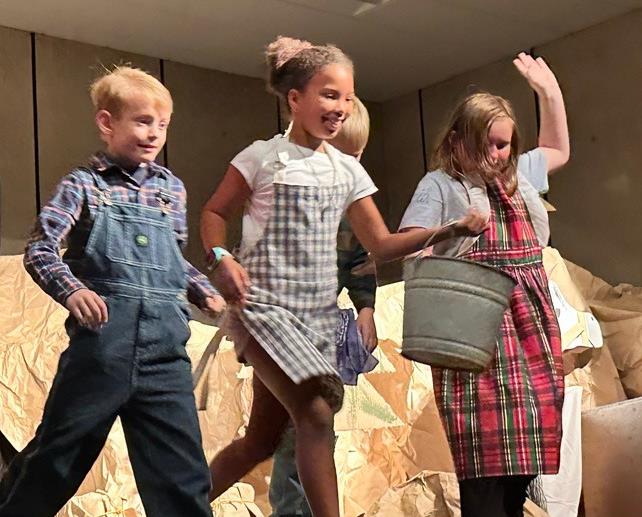
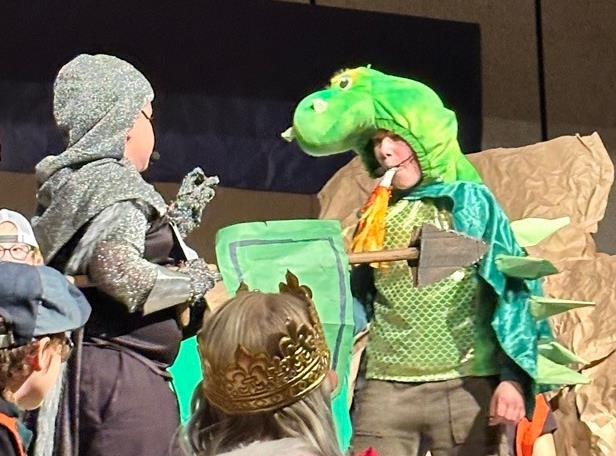
ArtReach's The
Reluctant Dragon - North Elementary
School, St Peter, MN
Dragon:
Dragons appeared in English literature during the Middle Ages. The
creature is wholly fictional, and is the focus of many legends from
Europe and Asia. Most stories envision the dragon as a reptilian or
crocodile-type animal that breaths fire. The fanciful image endures
with many contemporary stories, games and movies centering around
this creature. In Chinese culture, the dragon is a positive symbol of
strength and power.
Nom
de plume: A
French word for a pen name, false name or nickname. In The Reluctant
Dragon Mortimer describes Hairytoes’ name as a nom de plume,
complimenting him for it rather than ridiculing him as the Grody
Gobsters have done.
Herbivore:
A herbivore is an animal that gets its energy from eating plants, and
only plants. Widget and Hairytoes believe that dragons eat meat but
Mortimer tells them that dragons are herbivores.
"Mortimer
says
that dragons are herbivores."
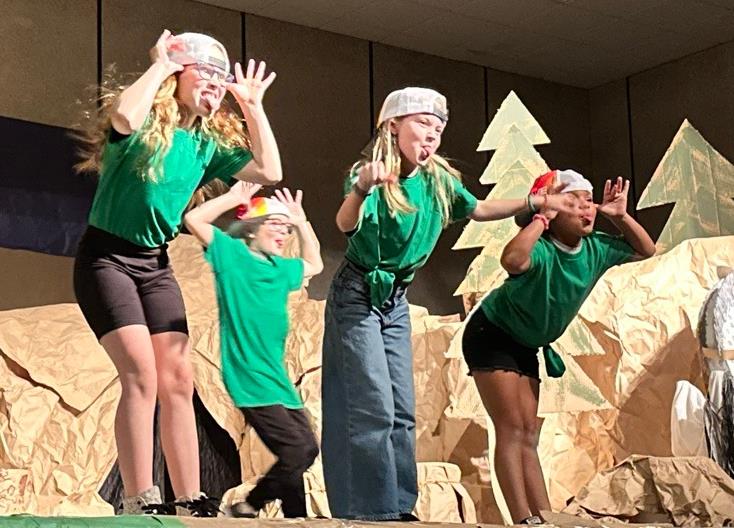
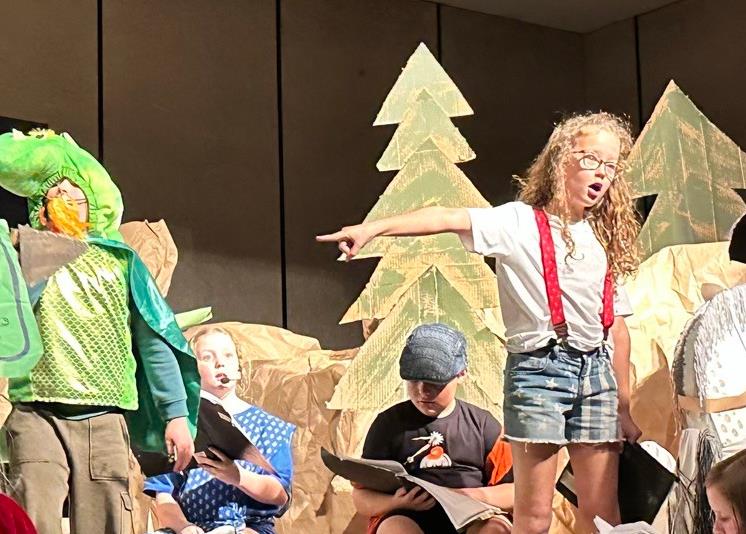
ArtReach's The
Reluctant Dragon - North Elementary
School, St Peter, MN
Mutton:
Usually a
stew of lamb, sheep or goat meat. Widget complains that they always
have mutton for dinner, obviously because his father is a shepherd.
Guru:
A Guru is a
wise man, usually a teacher, who guides followers in spiritual
advice. There are many examples in cultures around the world. In this
play, the Guru playfully references the rock and roll (or hippie)
culture of the 60s.
Gong:
A musical percussion instrument that takes the form of a flat,
circular metal disc which is hit with a mallet. In this play, the
gong is used to give symbolic authority to the Master Guru. This
sound is included on the CD of soundtrack and music. You may use a
real gong for emphasis if one is available to you.
Knight’s
Armor: The
most valuable items to a knight were his armor, weapons, and his war
horse. These three items were very expensive, meaning that only the
wealthy could afford to be knights. During the Middle Ages knights
wore heavy armor made of metal. In this play, Saint George may wear
armor if desired.
"The
Guru playfully references the 60s hippie culture."
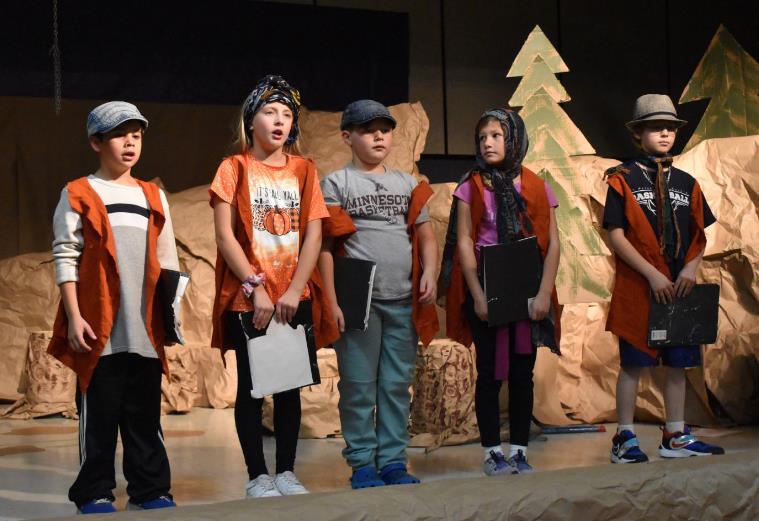
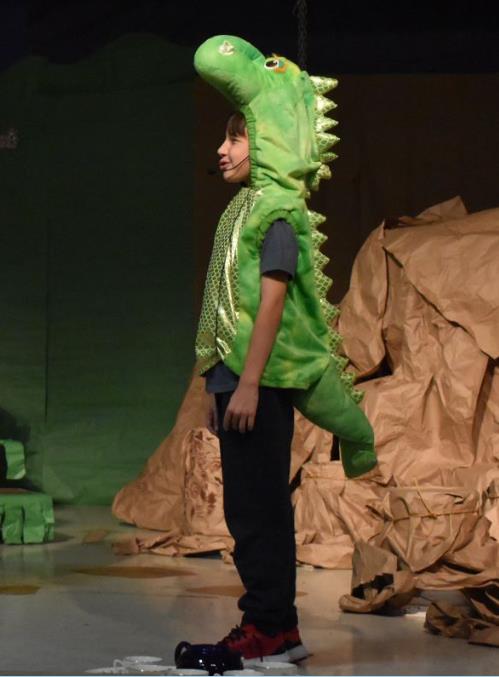
ArtReach's The
Reluctant Dragon - North Elementary
School, St Peter, MN
Ancient
Greece and Renaissance Literature:
Mortimer references these lofty subjects to emphasize that he prefers
to read about exciting events rather than to participate in them. The
Ancient Greeks had a tradition of a strict military and warrior
society. Some Renaissance literature describes violent scenes, such
as Shakespeare’s Macbeth.
A
Traditional English Tea Party: The
original tea party began in the 1800s as an “afternoon tea”
by royal Britain’s Anna, the Duchess of Bedford. Anna started
drinking tea and eating light refreshments when she became hungry in
the afternoons, since it was typical to eat only breakfast and dinner
at that time in Britain. She began inviting friends to join her and
soon the afternoon tea tradition was born. Usually served between 3
and 5pm, afternoon tea (sometimes referred to as “low tea”)
is very different from “high tea,” during which a more
hearty meal was eaten at the end of a work day, around 5:30 or 6pm,
by working classes.
"The
play has a happy ending when Mortimer’s friends share tea."
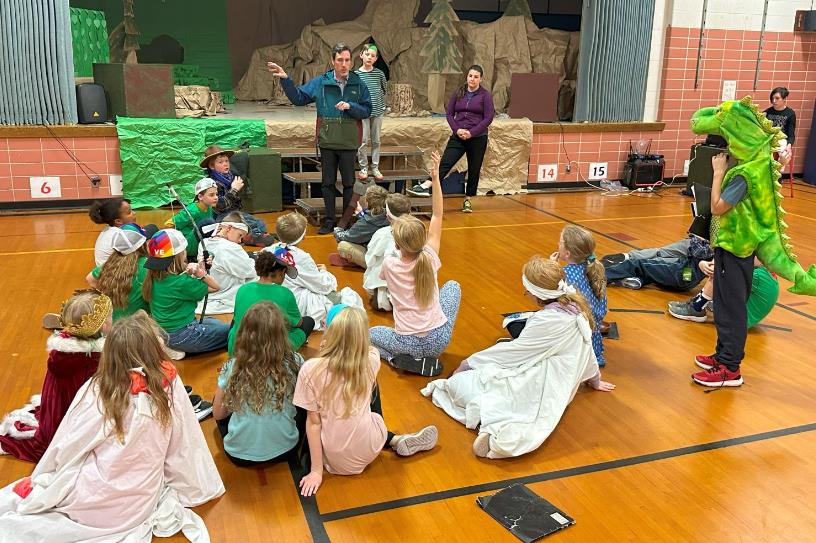
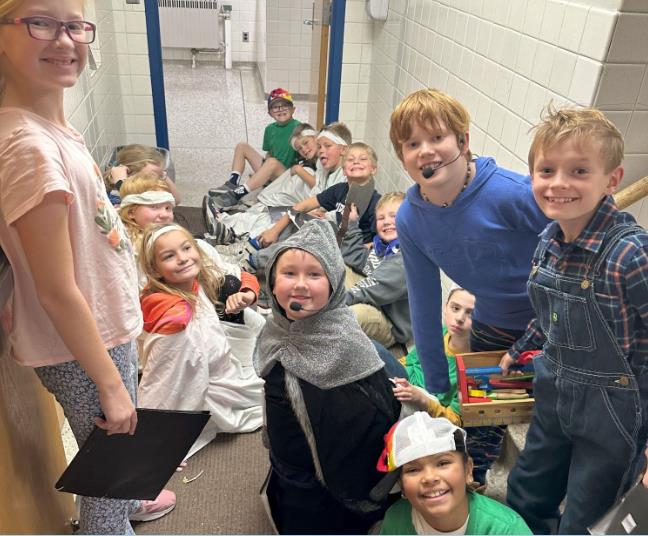
ArtReach's The
Reluctant Dragon - North Elementary
School, St Peter, MN
In
this play, ArtReach's 'The
Reluctant
Dragon', Mortimer
loves a good tea party and lives to have his friends around his
table! The trouble is, he doesn’t have any friends. The play has
a happy ending when Mortimer’s new friends finally sit down to
share his beloved tea.

ArtReach's
Kid Frankenstein Fun: Great Ideas for Classroom and Homeschooling
Monstrous
Summer Activities for Your Child to Enjoy
Indiana
Humanities is recognizing the 200th birthday of Frankenstein by Mary
Shelley with a statewide read and celebration of the book. In the
book, Victor Frankenstein, a brilliant scientist, pushes the limits
of science to create a living being, but then he regrets his actions.
The book brings to mind questions like: What's right and wrong? How
do we understand ourselves in relation to the world around us? How
far is too far? What responsibility do we have for our actions and
the things we create?
Though the
classic book is written for an older audience, its themes translate
to a wide variety of ages-even young ones-and deal with many
questions that we're still asking today. Here are a few ways you can
use Frankenstein to have important conversations with your child,
engage with the humanities and have a little fun too!
"Read
the book, Mary Shelley's Frankenstein."
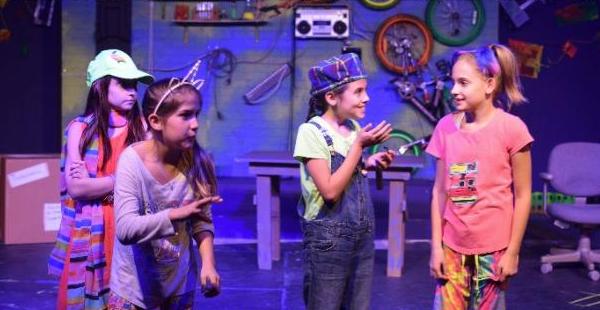
Performance of ArtReach's
Kid Frankenstein - Pearl Theatre, Houston, TX
Read
a young reader's or spinoff version of the book with your
child. There are lots to choose from for various ages:
Frankenstein: A
BabyLit Anatomy Primer by Jennifer Adams for babies and toddlers
Crankenstein by
Samantha Berger for ages 3-6
If You're a
Monster and You Know It by Rebecca and Ed Emberley for ages 3-6 years
Frankie Stein
by Lola M. Schaefer for grades 1 through 3
Lunch Walks
Among Us (Franny K. Stein, Mad Scientist) by Jim Benton for grades 2
through 5
Frankenstein
Makes a Sandwich by Adam Rex for grades 2 through 5
After you've
read the book, have a conversation with your child by asking them to
identify any monsters in the book. Why is he or she considered a
monster? Do those reasons mean he or she should be treated any differently?
"Frankenstein
is full of ways to engage younger audiences."
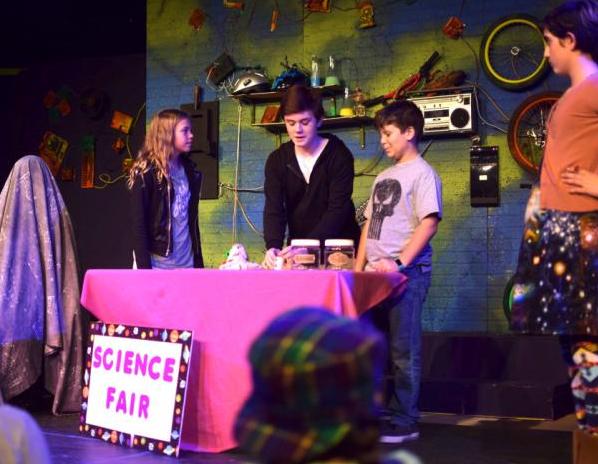
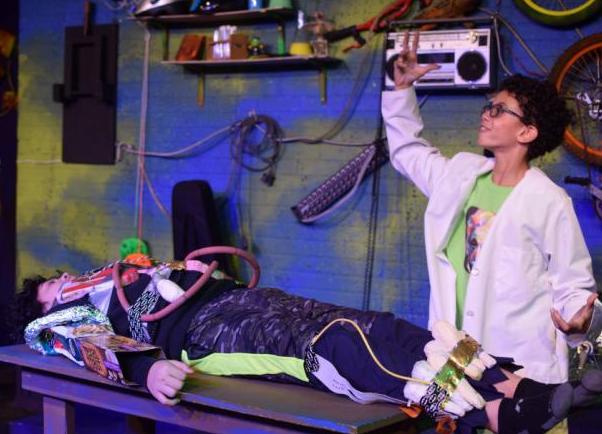
Kid Performance of ArtReach's
Kid Frankenstein - Pearl Theatre, Houston, TX
Create
a creature!
Victor
Frankenstein's creature probably came to life with electric
circuitry. Kids can experiment with circuits in a variety of ways:
Create circuits
with kids using salt dough, LEDs and batteries.
Try creating a
circuit on paper using copper tape, LEDs and coin batteries. Children
can decorate their paper circuits to look like monsters.
Using super
strong magnets, a battery and a copper wire, children can make a tiny
train by attaching the magnet to each side of the battery and coiling
the wire into a long tunnel for the "train" to travel through.
Have
a monster mash!
Make monster
masks with your child using a paper plate, crayons and other
materials. Then have them dance with you to "Monster Mash"
by Bobby Pickett or sing "If You're a Monster and You Know
It." Other monster songs include "The Purple People
Eater" by Sheb Wooley, "Monster Boogie" by Laurie
Berkner Band and "Calling All the Monsters" by China Anne McClain.
"Have
them dance with you to Monster Mash."
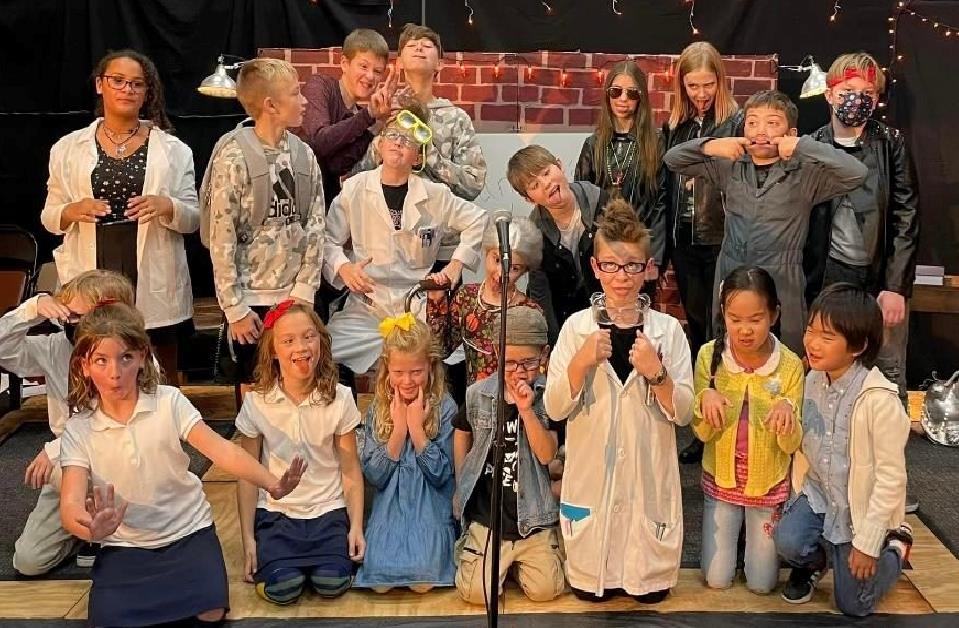
ArtReach's Kid
Frankenstein - Let Your Light Shine Youth Theatre, Hallsville, MO
Be
Dr. Frankenstein and make a scribble bot!
Consider
whether, like Victor Frankenstein, the inventor of a creation is
responsible for the actions of that creation.
This craft uses
a few supplies to make a little robot that draws entirely on its own.
The question then asks: Are its scribbles "art"? If so, who
is the artist-you or the bot? Is the bot alive, or does it just seem
to be? What can you change to make your scribble bot move differently?
Things you'll
need: A 6" length cut of a pool noodle, 3-4 Thin markers,
2 Rubber bands, Craft materials for decoration (such as googly eyes,
foam stickers, chenille stems and feathers), Battery-operated
electric toothbrush, Spare AA batteries, Safety scissors, Tape,
Paper, Trays to hold the paper and contain the bot while it
scribbles, Activity booklet, Sign holder and table sign.
How to make
it: Build the body. Use rubber bands to attach three or four
markers to the pool noodle. These will be your creature's legs.
The drawing tips of the markers should point down and extend past the
bottom of the tube. Now make your creature unique. Decorate it and
give it special features. Share!
"The
book's themes translate to a wide variety of ages."
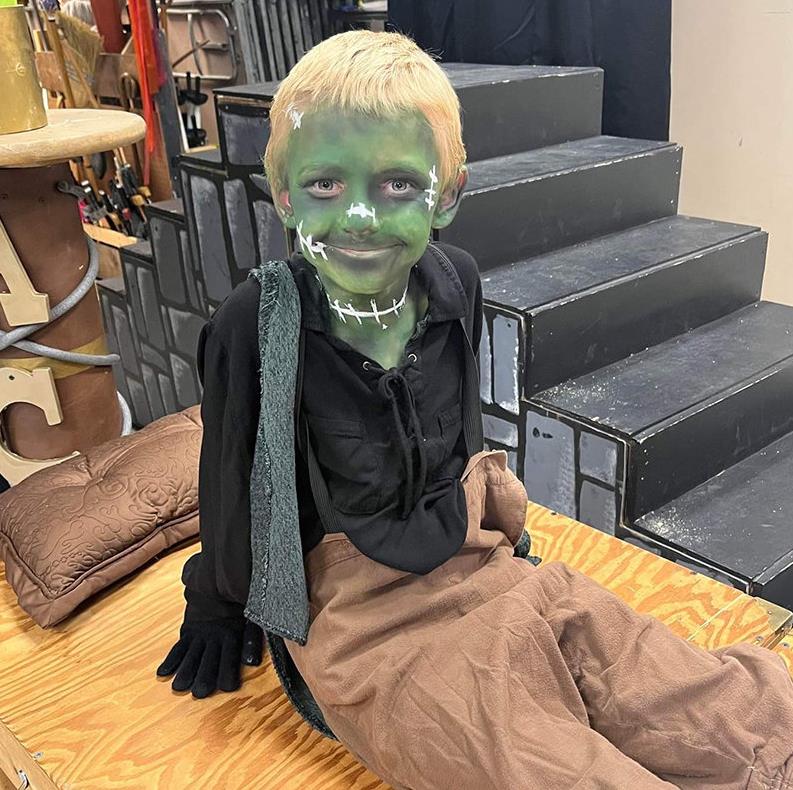
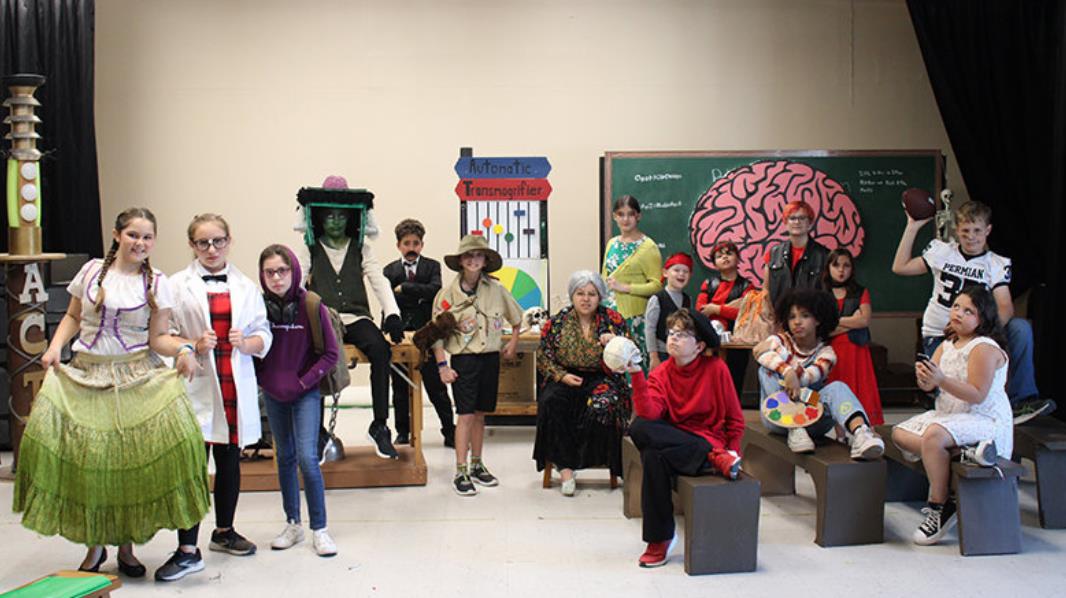
ArtReach's Kid
Frankenstein - Mesilla Valley Children's Theatre, Las
Cruces NM
Though it may
seem like a book for older children or grownups, Mary Shelley's
Frankenstein is full of ways to engage younger audiences. Create
anything cool? Be sure to share your Franken-fun on social media by
tagging @INHumanities and using the hashtag #itsalive! Most of these
activities are drawn from the Frankenstein200 kit created by Arizona
State University and the National Informal Science Educators Network.
The kit is free for download at https://www.nisenet.org/Frankenstein.
You can also find more adult-friendly Frankenstein content on our website.
________________________________________
This post
was written by Bronwen Carlisle, executive assistant and program
associate at Indiana Humanities, which connects people, opens minds
and enriches lives by creating and facilitating programs that
encourage Hoosiers to think, read and talk. As a convener, leader and
partner, Indiana Humanities promotes the public humanities and
engages Indiana's community of minds to create stronger, more vibrant
communities. Learn more at www.indianahumanities.org.
Classroom
Activities for ArtReach's "Alice
in Wonderland"
Dreamy
Ideas for bringing ArtReach's Play to Life for Your Students
Tell
students that they will be reading Alice
in Wonderland, one of the most famous children's stories ever
written. Explain that the story has been retold in many versions over
the years. They will be reading the original version, first published
in 1865.
Tell
students that Alice in Wonderland was written by Lewis Carroll for a
real girl named Alice Liddell. Carroll was a friend of Alice's family
and would often make up stories to tell the three Liddell daughters.
One summer day, after a riverside picnic, the girls begged him to
tell them a story. He began by sending Alice down a rabbit hole,
having no idea of what would happen to her next. Carroll made up
Alice's adventures in Wonderland as he went along; several years
later he wrote down the story from memory for publication.
"Discuss
why the place Alice visits is called Wonderland."
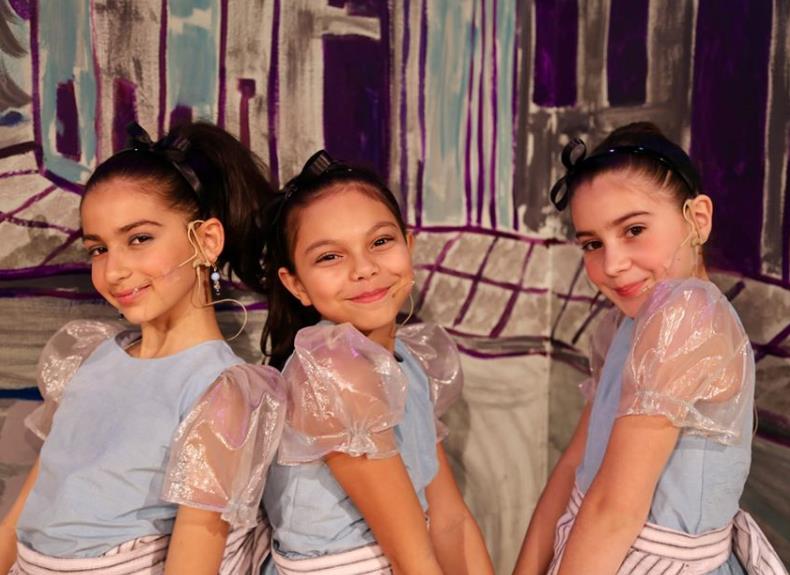
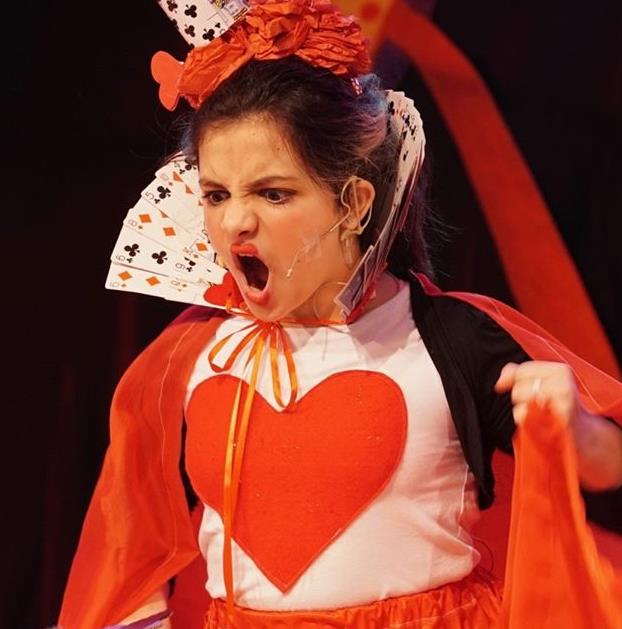
ArtReach's Alice
in Wonderland - PS 295 Studio School of Arts & Culture,
Brooklyn NY
Ask
students to define fantasy and discuss the characteristics of this
genre. Explain that Alice in Wonderland is a classic example of a
kind of story called fantasy. If the students are unable to provide
the characteristics, then list the following three elements of
fantasy on the board and discuss them:
The
setting may be a strange or unusual place.
Some
of the characters may not look or act like real people or animals.
Things
happen that could not happen in the real world.
Choose
the activity that is best suited for your class.
Ask
each student to make a "Dream Book."
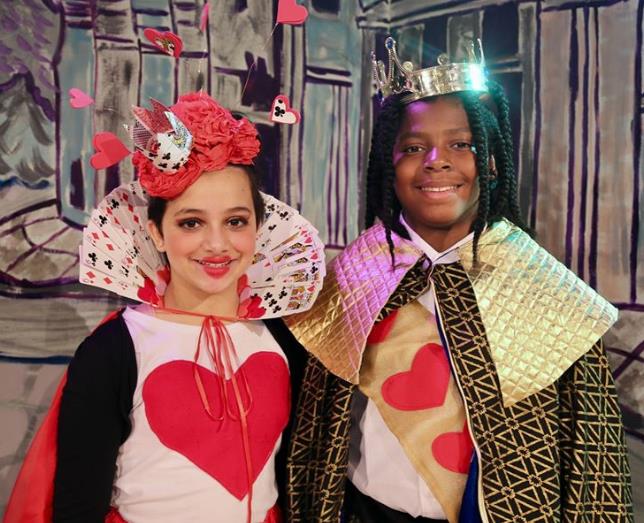
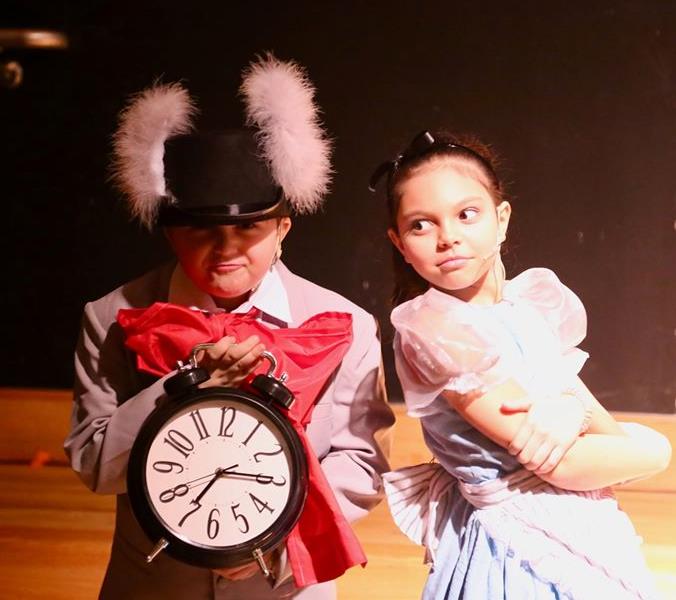
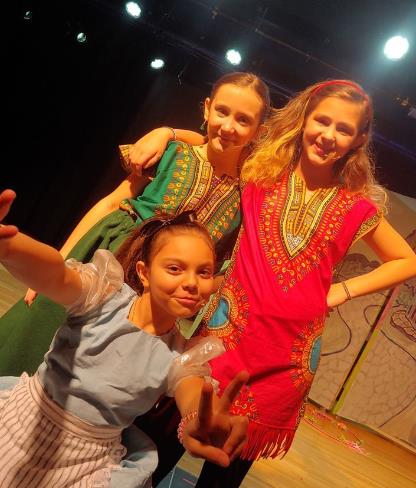
ArtReach's Alice
in Wonderland - PS 295 Studio School of Arts & Culture,
Brooklyn NY
OPTION
1: Explore the genre of fantasy by drawing on students' prior
knowledge of literature. During a whole class discussion, make a list
on the board of books students have read that are fantasies. Examples
might include Charlotte's Web, Stuart Little, The Wizard of Oz, or
The Wind in the Willows.
Assign
students to small groups, selecting a title for each group that is
familiar to all of them. Ask each group the following questions about
their title:
What
was strange or unusual about the characters in the story?
What
was strange or unusual about the setting of the story?
What
events happened in the story that couldn't happen in real life?
Have
the groups share their responses with the class and make comparisons
about the fantasies they discussed.
OPTION
2: Remind students that each of us enters our own fantasy
world while we're asleep and when we daydream. Ask each student to
make a "Dream Book," by folding and stapling together
several pieces of paper.
Have
students draw an illustration for the cover. Then ask them to record
a dream, or part of a dream, they remember. They may also record
daydreams they've had in which they've done things that they couldn't
do in real life.
Distribute
copies of Alice in Wonderland,
and call students' attention to the cover illustration. Ask students
what clue they can find in the illustration that the book is a
fantasy. Have a volunteer identify the animal in the tree as the
Cheshire Cat, and discuss how it is different from a real cat. Next
have students study the title; ask them why they think the place
Alice visits is called Wonderland. (Thanks to Scholastic.)
ArtReach's
Beauty and
Beast:
Fun Activities, Exercises
Before
the Play: Talk about
theatre and what a play is. What other plays have you
seen? Describe them to the class. Why do you think
certain parts of those plays are memorable to you? What do you
expect this play will be like? What is the difference between
seeing a play on television or movies and seeing actors perform it live?
Discuss you
students the proper etiquette for audience members during a live
performance. Impress upon them that the actors they see are
live people who care very much how you respond to the work they are
doing. Young audience members should learn the meaning of
applause and laughter and that they should be polite to the people
who are performing for them.
"Kids
will participate by making sounds, wind, music, wolves."
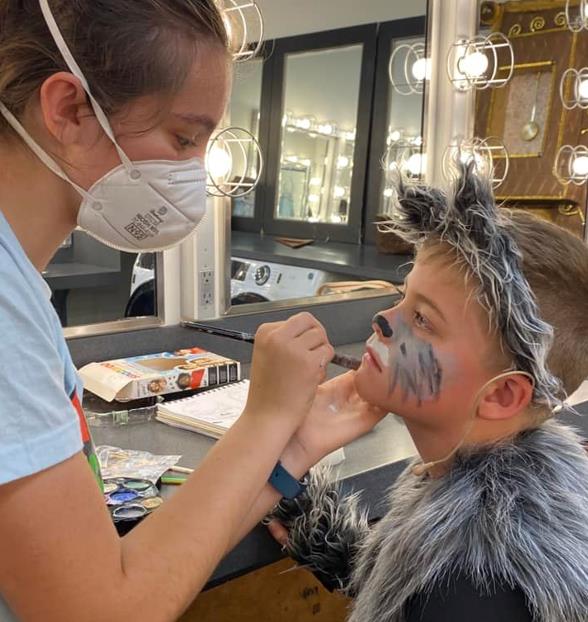
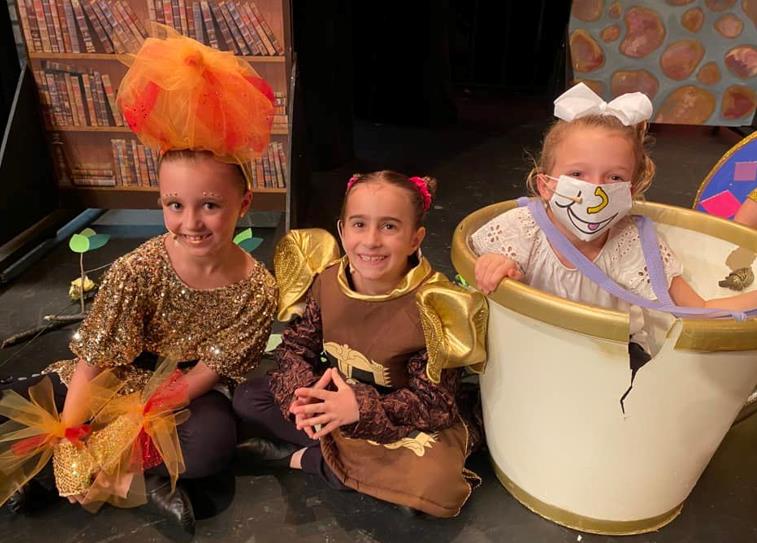
ArtReach's Beauty
and the Beast - Theatre in the Park, Severna Park MD
Read the
original story and the synopsis of the play that appear in this
Teachers Guide. How are the stories alike? How are they
different? Talk about the practical consideration of putting on
a play and why the actors might need to adjust the story in order to
present it on stage.
The play takes
place in France where they used to tell fairy tales. Look up France
on the Internet and in books, locate it on the globe. Talk
about what we know about the country, history, music and the
people. What kinds of clothes do they wear and what did the
wear in years past? Remember your answers when you see the
actors in their costumes. Or if you are performing in the play
use the pictures you find to help create your costume.
During the
play, children will be asked to participate by helping make sounds,
wind, music, wolves, etc.. Describe a storm, scary forest,
angry mob or ferocious wolves and talk about how they sound and
move. Point out the actual events or other plays or movies you
may have seen. How does your play relate to events in "real
life” or other "fantasies”?
Talk about
clothes and what they say about your personality. Name some of
your favorite movie stars or musicians and how the clothes they wear
shape the image we have of them. What makes some clothes come
into fashion why others go out of style. Describe your favorite
shoes, hat and coat. What makes you like them? How do you
feel when you wear them?
After
the Play: Discuss in more
detail the play you have just seen. Who is your favorite
character and why? Talk about how the actors created the
illusion of many things such as the castle, the forest, the
marketplace and the invisible painting that Marcel sets up.
Talk about how you were asked to sue you imagination as opposed to
movies and cartoons that show you a picture of everything.
"What
is the meaning of this famous story?"
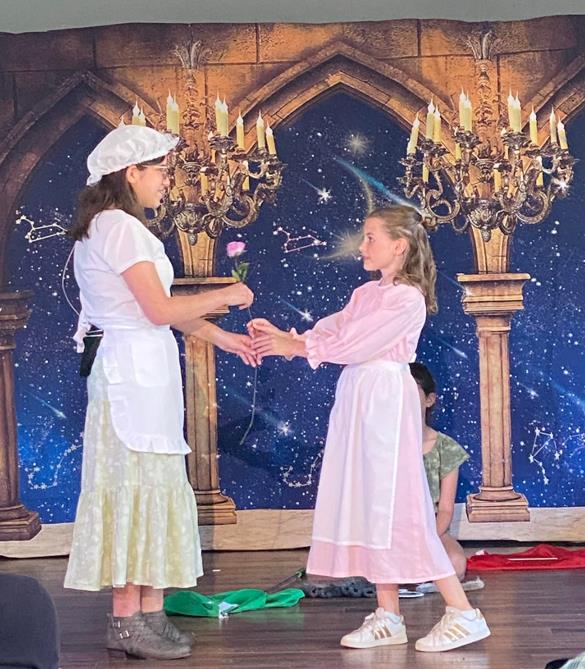
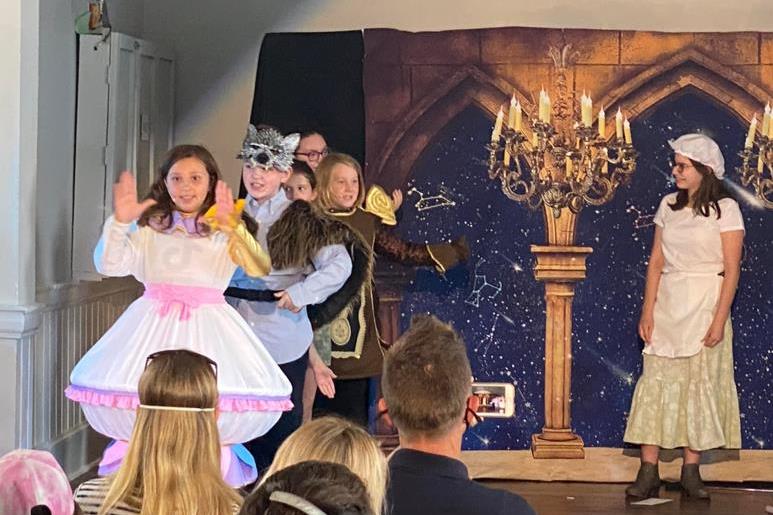
ArtReach's Beauty
and the Beast - Theatre in the Park, Severna Park MD
Talk about some
of the characters you saw in the play such as the Villagers and
Household Servants. What did they do with their voices and
bodies to convey their character to you? Would you like to try
your hand at acting? Write down the names of characters such as
Beast and Wolves. Come up with crazy names as Huey Kazooie and
show the class how Huey would act and talk. Choose other
characters, perform them and ask your classmates to guess who you are.
Charles
Perrault wrote many play besides Beauty
and the Beast. What titles are you familiar with?
Can you recount these stories? Which do you like best and why?
What do you
think a magical Prince-turned-Beast would actually look like?
Draw a picture of the Beast showing how he thought he looked once
like a Prince. Draw a picture of the Prince before he turned
into a Beast.
What is the
meaning of this famous story? When people say "his bark is
worst than his bite” what do you think they mean? The
Prince embarrassed when he realized he had been tricked and turned
into the Beast. What might he have done to prevent this embarrassment?
"Would
you have the courage to meet the Beast?"
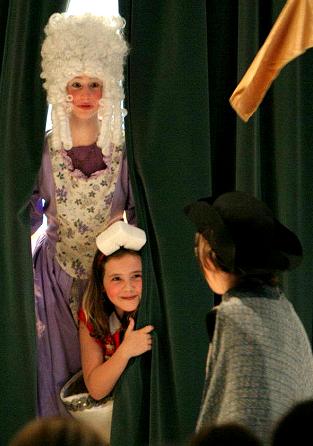
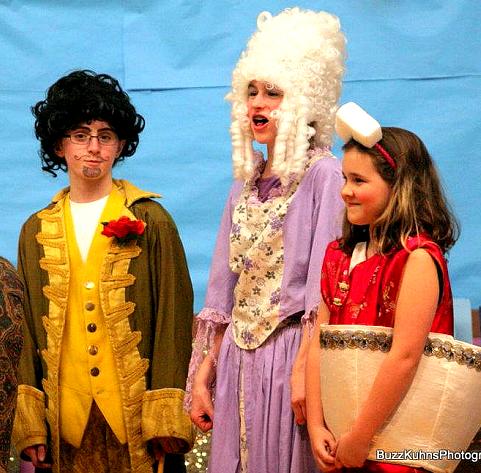
ArtReach’s Beauty
and the Beast, Monkton Central School, VT
Classroom
Activities:
CLASS
STORY: Read a version of the story as a class.
View an animated version and compare the two. After seeing the
show, compare all three genres.
BEING
A HERO: Ask the class what it means to be a hero.
Brainstorm a list of qualities that make a person seem like a
hero. In groups, pick the most important qualities and identify
heroes today. Share as a class. Discuss whether or not there is
a hero in Beauty and the Beast.
JOURNAL
ACTIVITY: Have students imagine that they are in
Beauty’s shoes. In order to save their fathers, the
students have to live with a terrifying beast. What would it feel
like? Would the students have the courage to do it?
"YOU
ARE A HERO!”: Ask students to write about a time
in their lives when they had to overcome something or helped someone.
FROM
THE OUTSIDE IN: Have students imagine that they could
only show people their worst qualities. No one would ever know
the good qualities they had deep down inside. What would that
look like? What would it feel like? Have students draw
what that person would look like, and write a story to go along with it.
FRACTURED
AND FUNNY: Have students write a fractured version of
Beauty and the Beast. Explain that a fractured fairy tale is made to
be humorous by changing the story in a surprising way; like changing
a character or adding today’s language and events to the
story. Encourage the students to take creative risks.
NOW
YOU SEE IT, NOW YOU DON’T: The element of magic is
common in fairytales. In Beauty and the Beast, things
aren’t always what they seem. Explore optical
illusions. Look at examples as a class. View optical
illusions as a class using the internet and books.
"How
do you define beauty?"
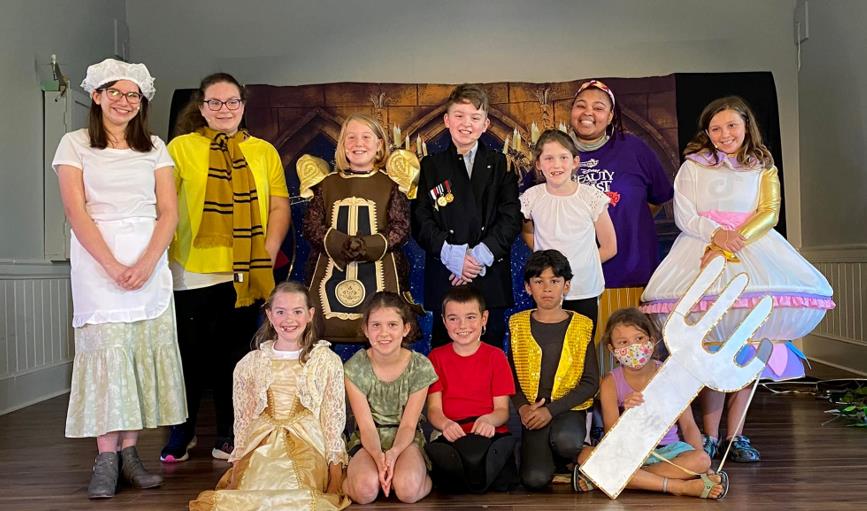
ArtReach's Beauty
and the Beast - Theatre in the Park, Severna Park MD
AROUND
THE WORLD ONCE UPON A TIME: Research different fairy tales
from around the world and different times.
HANDING
INFORMATION DOWN GENERATION TO GENERATION: Gather students on
the rug and have them sit in a circle. Explain that fairytales
were handed down through word of mouth. Pretend that each
student sitting in that circle is another generation. Play a
game of "telephone” (one person thinks of a sentence and
whispers it in the person sitting next to him/her’s ear, and
that person passes, and so on) to demonstrate how stories change.
RE-WRITE
HISTORY: Ask students to rewrite the ending of Beauty
and the Beast. What would the play version of this look
like? After rewriting the way the story turns out, have
students design a scene from their versions (the castle, forest,
etc&ldots;) using only their imaginations to guide them.
FINISH
THE PICTURE: Have students design what the costumes
would look like. Remind them that the story can take place
anywhere and in any time period.
BEAUTY
IS: Ask students to define beauty. This can be done
through words or pictures
ArtReach's
'A
Christmas Carol' Classroom Activities
Classroom
Discussions for ArtReach's A
Christmas Carol
Read the original story ‘A
Christmas Carol’ by Charles Dickens or the ArtReach School
Play, adapted from the Dickens Classic. What do you think is
the "main theme” of the story? Consider other stories that
the students are familiar with such as Cinderella,
Snow White and the Wizard
of Oz. What aspects of these stories are the same? Which are different?
1. What mistakes do you think
Scrooge made in the story? When is he selfish? When
is he kind and generous? What are his consequences and rewards for
his actions?
2. Can students think of times
when they’ve felt or acted like Scrooge?
3. How does Scrooge change
throughout the story? What is his "character development”?
(Scrooge
develops from a grumpy old miser to a happy, generous person. He is
shown that life is short, and that it is a person's responsibility to
look after others. He comes to realize that it is possible to be
happy, and happiness has nothing to do with money.)
"Read
and
discover the Charles Dickens classic."
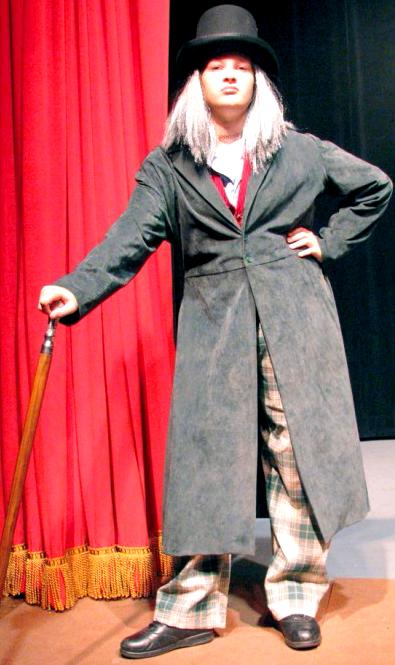
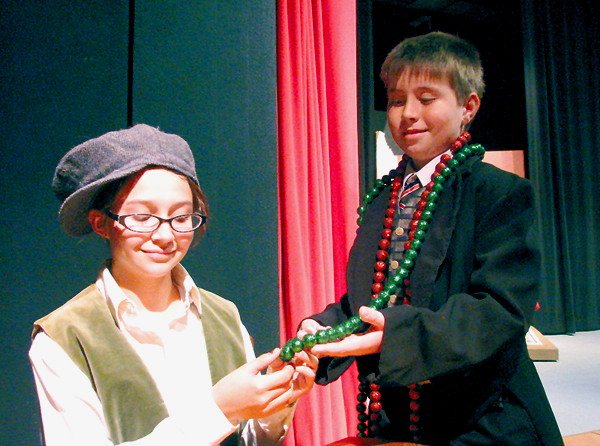
A
Christmas
Carol, Paris
Community Children's Theatre, Paris TX
4. What specific things does
Scrooge do to show he is a bad person? To show he is a good person?
(Bad: mean to
Cratchit; refuses to give to charity; doesn’t like Christmas;
etc. Good: gives Cratchit a raise; gives money away; sends turkey to
Cratchits; cheerful about Christmas; etc..)
5. What would be a good essay
or discussion topic for the story (something about why so many
people, especially children, love the story).
(For one thing,
the story is simple – the lesson is to be good to people,
because that is the only way to be happy. Children can relate to the
metaphorical characters: the grumpy old man, the poor clerk, the
joyful nephew, the saint-like little boy. The story is stark and
vivid. It is easy to understand but hard to forget.)
ArtReach's
The Jungle Book Classroom Activities
Activities &
Discussions for ArtReach’s The
Jungle Book
"I
LOVE your version of The Jungle Book. I have looked at 5
different versions and yours is the best! I love the fact that
there is the focus on Community and that there is such flexibility as
far as roles. We have done the Disney Jungle Book but that
doesn't have the heart that yours has."
Diana Guhin Wooley, LAMB Arts
Ltd, Sioux City, IA
Kipling’s
Characters: Take a look at the list of characters at
the beginning of the script. Look at each name and consider the
personality traits of each one. What words would you choose to
describe Mowgli: Brave, strong, curious, impulsive, funny,
adventurous? What kind of traits would you use to describe yourself?
If you are brave, give an example of when your bravery was present.
"Have
you ever encountered a wild animal?"
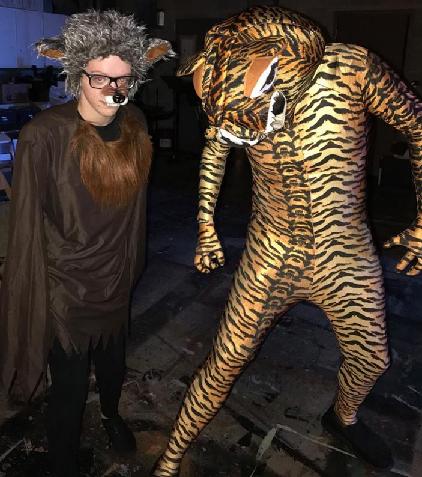

Audience becomes the
Man-Village helping Mowgli save the Jungle.
Create
Your Own Jungle: Discuss the various things you might
find in a jungle such as plants and nature: flowers, trees, vines,
moss, rocks, creek. What kind of animals would you find there?
Snakes, frogs, vultures, lions, elephants, butterflies, mosquitoes.
Have students choose a jungle "thing”. Don’t tell each
other what you have chosen. Now draw a circle on the floor and have a
few students go into the circle and become their "thing”.
Have others enter the jungle and try to guess what the
"things” are. You can also do this activity without the
guessing game. Have students enter the "jungle” and simply
enjoy it.
Moral
of the Story: Think of
aphorisms such as "a bird in the hand is worth two in the
bush”. What aphorisms would you use to describe the message of
The Jungle Book? A moral is: A lesson that is learned from a story or
an experience. Think of stories that have morals at the end like
Aesop’s Fables. What do you believe is the moral of The Jungle Book?
What
if you were raised as an animal in the wild?
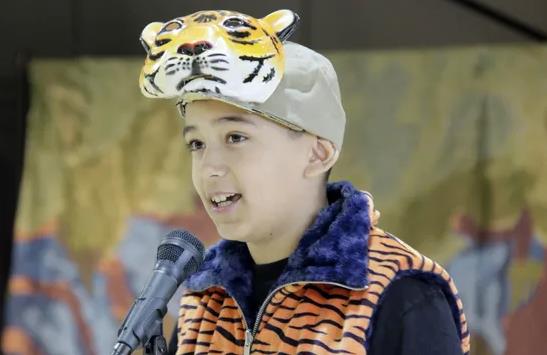
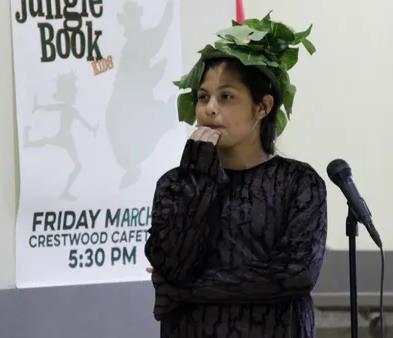
Crestwood Elem
School, Crestwood KY
Magic
Near Your Home: Have you ever encountered a wild
animal where you least expected it? A deer in your backyard, a turtle
crossing the road, an opossum in an alley, a snake slithering in your
garden? Tell the class about your experience. Why is it so exciting
to encounter wild animals in a human setting? Should we continue to
have these encounters or should we work to have animals and humans
live apart?
Raised
by Wolves: What do you
think it was like for Mowgli to have brother and sister who are
wolves? What if you were raised as an animal in the wild? Consider if
your family was made up of porcupines, lions, elephants or squirrels.
What would you wear? What would you eat? What sound would you make
when you are hungry or frightened?
"Turn
your school or theatre into a jungle!"
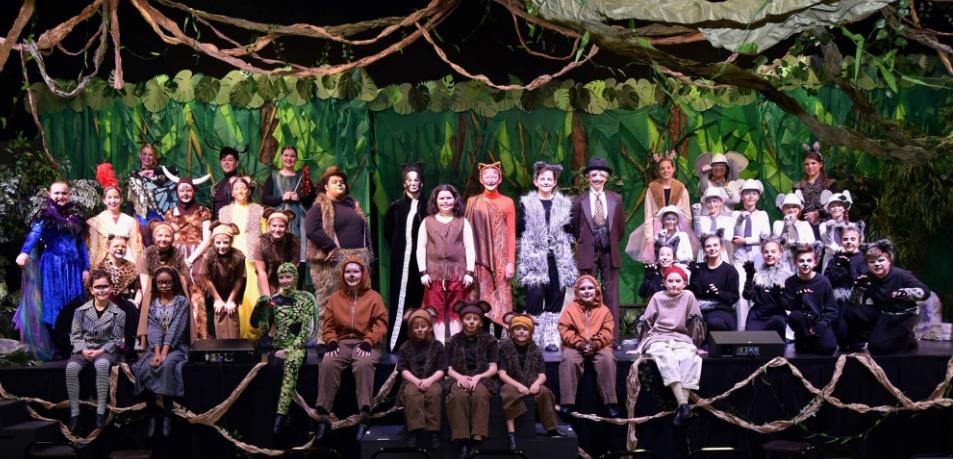
ArtReach's
The Jungle Book - Kankakee Valley Theatre Association,
Wheatfield IN
Water
Awareness: Study the effects of water on human
civilization and on the plants and animals of the world. Too much
water can cause floods and drowning while too little water can cause
drought with thirst and hunger as a result. Think about your day as a
human and look back on your activities to remember how many times a
day you needed water. How would you brush your teeth without water?
How would you take your vitamin pills without water? What if you had
to go for weeks or longer without a bath? Write a paragraph on what
water means to you.
Pets
as Wild Creatures: If you
have a pet at home, it’s likely to be a cat or dog. Your cat may
be a descendant of panthers like Bagheera. Your dog may be a
descendant of a wolf like Akela. Imagine your pet in the forest
alone. How would your pet handle an encounter with Shere Khan? How
would you train your pet to live in the jungle?
Animal
Awareness: Look around your classroom for depictions
of animals everywhere. Look on each others’ clothing, on the
illustrations on your shoes and backpacks. Outside of the classroom
look for illustrations of animals on wallpaper, carpet, jewelry,
sculptures and designs on architectural buildings. Humans have always
used animals for design, art, function and pleasure. Keep your eyes
open and always look for the animals that are all around us!
Study
Animals in Preparation for ArtReach's
The Jungle Book
Look closely -
There are pictures of animals all around us
Animal Awareness: Look
around your classroom for depictions of animals everywhere.
Look on each others’ clothing, on the illustrations on your
shoes and backpacks. Outside of the classroom look for
illustrations of animals on wallpaper, carpet, jewelry, sculptures
and designs on architectural buildings. Humans have always used
animals for design, art, function and pleasure! Keep your eyes
open and always look for the animals that are all around us!
|
 |
 |
 |
 |
|
mule, man |
bird (eagle) |
bird (chicken) |
bird (penguin) |
The Best Activity Ever!
Go to the Zoo! Early on in the rehearsal process, see if you
can arrange to have the whole cast to take a trip to the nearest
zoo. Have all performers go to each of the animals that will be
represented in play. While there, in front of the animal,
discuss the looks, walk and sounds that the animal makes. Let
everyone play around with imitations. These tiny performances
may be funny and silly. Back at the rehearsal site, recreate
these imitations and see how they effect the mood and personality of
the character they will play. Use what you have learned
at the zoo to play your Jungle-Person!
"Pictures
of animals are everywhere!"
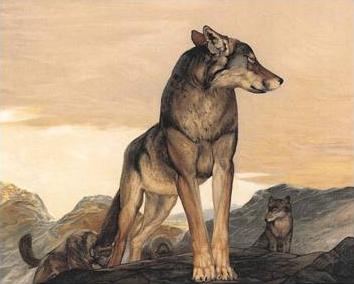
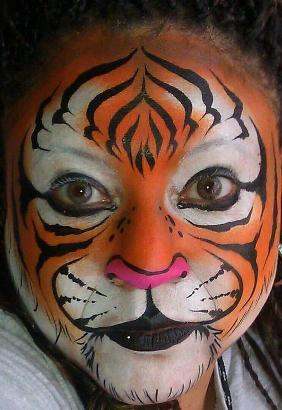
It’s all
Happening at the Zoo-Who!
How
to Fold Paper Cranes
Classroom
Activity for ArtReach's A
Thousand Cranes
See the following diagram or
search the Internet for the many diagrams on "how to fold
paper cranes".
If you want printed instructions, try those from Informed Democracy
at: PO Box 67 Santa Cruz CA 95063 USA, Phone USA 800-827-0949.
Time:
With only a little practice, each crane can be folded in less
than three (or even two!) minutes.
Helping
hands: Anyone from about 9 or 10 years old can
master this quickly - and it's a great family activity!
Paper:
For really spectacular cranes, wonderful patterns and colors
of "origami" (Japanese paper folding art) paper can be
purchased from stationers or through specialist origami
suppliers. Colorful (but not always color-fast) medium
sized craft squares from a discount stationer cost about $20 for a
thousand. Also consider buying larger squares andhaving them cut down
to size by a friendly printer, as this can reduce the cost to less
than $8 per thousand. Just about any colorful paper can be used, so
if your budget is very limited and/or if you want to "do your
part" for recycling, offcuts of wrapping paper or even high
quality advertising brochures will generally take a good sharp fold
and will look great.The size of square you should use depends on what
you intend to do with your cranes:
If you will be sending your
cranes overseas, the need for economical transport suggests use of
squares from about 3½ to 5 inches. If you are displaying
flocks of cranes and not transporting them, then larger squares will
make cranes with a greater visual impact. Try various sizes and see
what you think! Hint: if you intend to transport your cranes, they
will be more compact and less likely to be crushed in packing if you
do not fold their wings down and do not spread or inflate their
bodies out as some folding instructions suggest.
Folding
Instructions
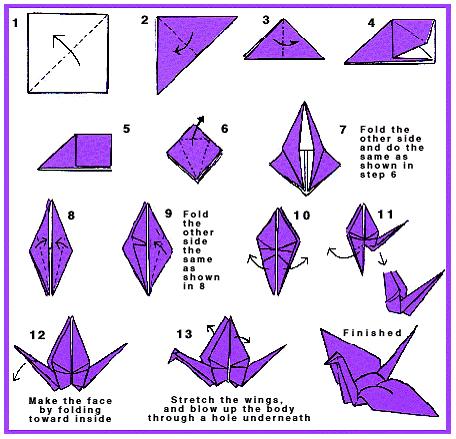
Presentation:
You have many possibilities for arranging or
presenting your cranes: As individuals; Gathered in loops or
rings; Flocking together in garlands;
In mobiles;
Glued onto boards
to make pictures and spell out messages.
Hanging
material: If
you are making garlands of cranes, you can thread them on wool,
cotton or fishing line, using a needle to pass it through the base of
each crane and out the pointed top of the back. Secure both the
base and the uppermost crane with part of a match, toothpick,
bead or similar. Knot a loop in the top of each strand so that
they hang to the same length.
Adding
messages: Consider attaching a message to your
garland, ring or mobile of cranes or to each individual crane. You
can: Write concealed messages or wishes on the blank or white
side of the paper before a crane is folded, and/or;
Write a message on the wings of a folded crane, and/or Write a
message on a strip of colorful paper attached to a garland, ring
ormobile of cranes.
"Write
a message on the wings of a folded crane."
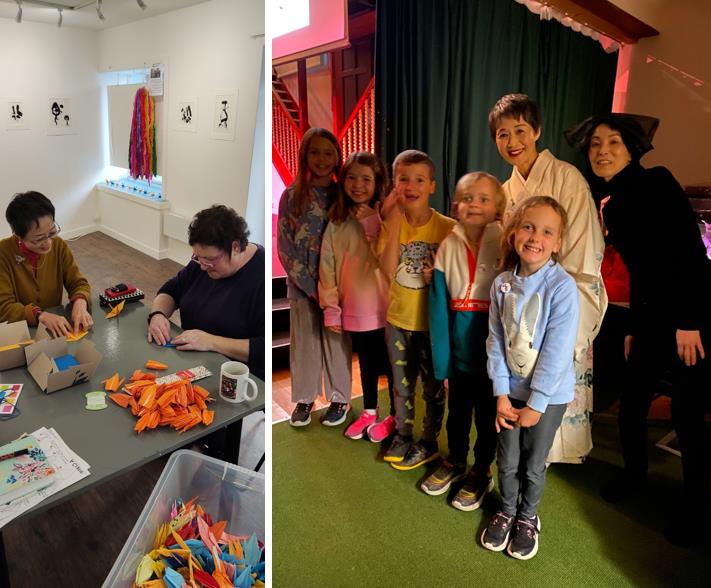
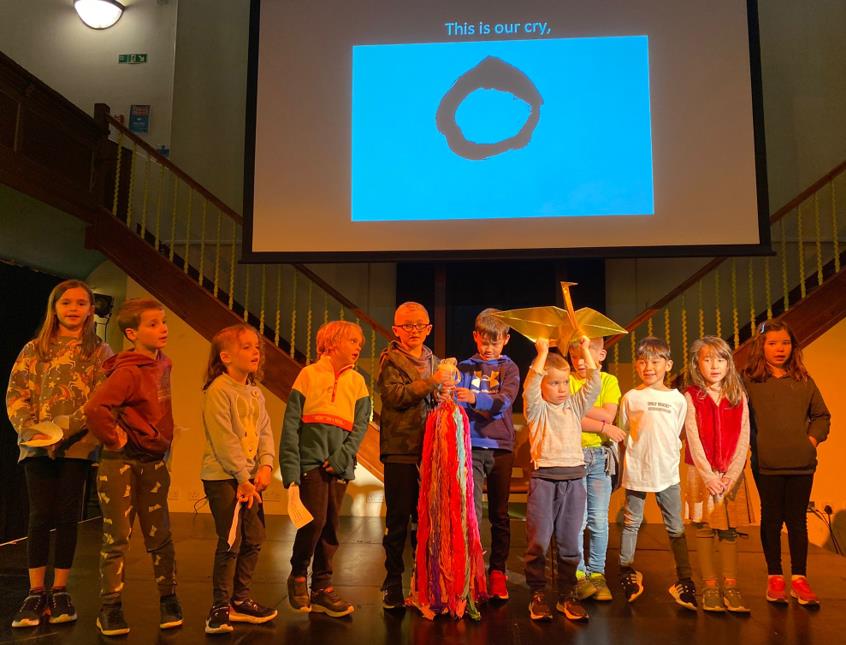
ArtReach's
A Thousand Cranes - Orkney Japan Association - Scotland
What
do we do with the cranes once they are folded?: You
can send your cranes to a Peace Park or Monument: Office of the
Mayor, City of Hiroshima, 6-34 Kokutaiji-Machi, 1 Chome Naka-ku,
Hiroshima 730, Japan. Some projects donate their cranes to
brighten the lives of residents Some projects donate their cranes to
brighten the lives of residents and patients in nursing homes or
hospitals, especially those treating leukemia or cancer, thus
developing a different sort of link to the Sadako story.
Children's
Peace Monument - Hiroshima
Japan
(From from:
https://www.pcf.city.hiroshima.jp/kids/KPSH_E/top_e.html; PCPA -
Pacific conservatory of Performing Arts - Study Guide for "A
Thousand Cranes")
After Sadako died, her
classmates said to each other, "Let's do something for
Sadako." That they, her friends, were able to do nothing for her
left a painful feeling in their hearts. Someone said, "Can we
erect a gravestone for her? If it is nearby, we can visit it every day."
"Let
no more children fall victim to an atomic bombing."
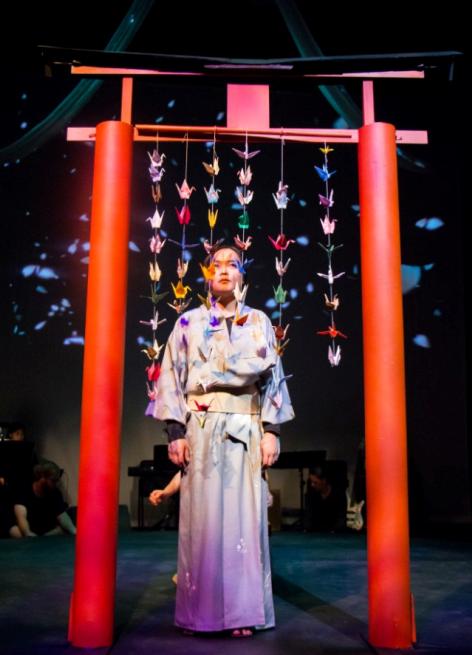
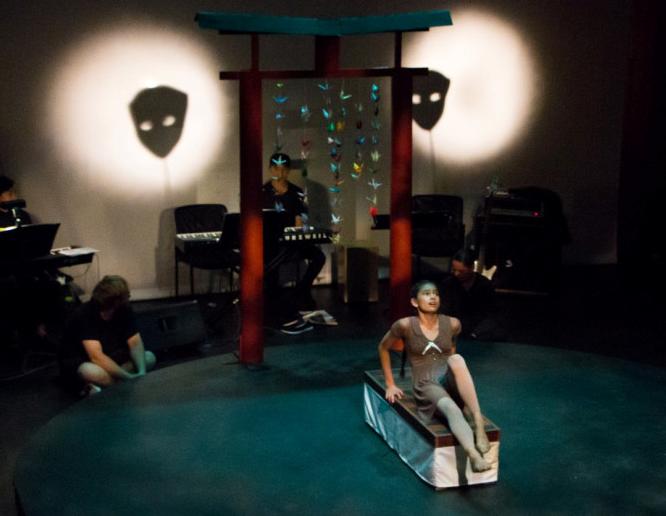
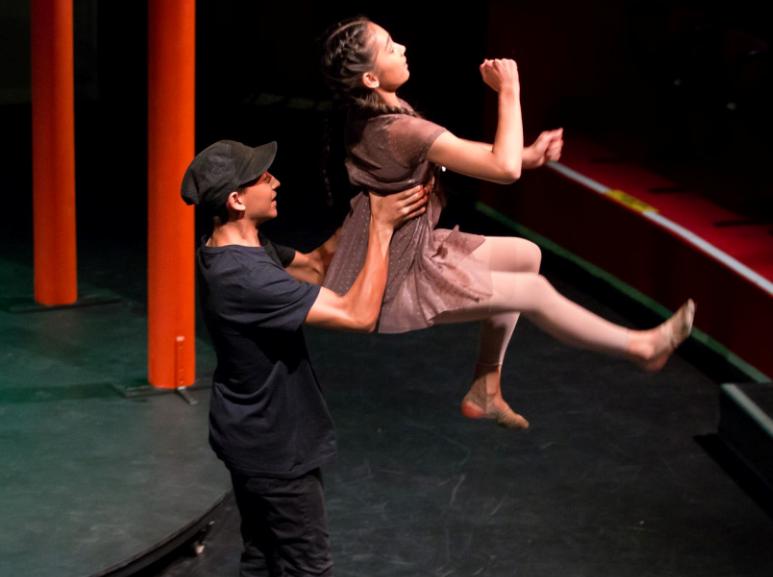
Gemini Collective, Adelaide,
AU - Professional Production
Sadako's classmates take
action. "What if we make a monument in Peace Memorial Park? Not
just for Sadako, but for all the children who died from the atomic
bomb." "Do we have what it takes to do something like
that?" The students were worried. "But I really want to do
something for Sadako." "I want to get rid of atomic
bombs." These were the emotions that moved the group to action.
Children around Japan
cooperate with the movement. Sadako's former Bamboo classmates began
a movement to raise funds for a monument. Their call elicited a huge
response that they had not anticipated. More than 3000 schools around
Japan sent money and letters saying, "Please use this to help
build the monument." In January 1957, it was officially decided
to build the Children's Peace Monument in Peace Memorial Park. The
statue was completed on Children's Day (5 May) in 1958, two years
after Sadako Sasaki's death.
Though Sadako and the other
children who had passed away would not return, the inscription carved
into the stone in front of the monument at least carried the hope,
"Let no more children fall victim to an atomic bombing."
Laura
Ingalls
Wilder: Voice of the Prairie
Study Guide by
The Rep, Imaginary Theatre Company, St. Louis
Here are some excerpts from
The Rep's Study Guide which is a component of a recent tour of Laura
Ingalls Wilder: Voice of the Prairie to local schools. You
may access the entire Study Guide here: https://www.repstl.org/study-guide-archive/
"Study
Guide by The Rep, Imaginary Theatre Company, St. Louis"
ArtReach's Laura
Ingalls Wilder - Tour photo, The Repertory Theatre of St. Louis
Words
to the Wise (Glossary)
Covered Wagon: A large
covered wagon with an arched canvas top, used especially for prairie travel.
Scarlet Fever: A
disease occurring predominately among children and characterized by
high fever.
Pioneer: Someone
who ventures into unclaimed or unknown territory to settle.
Dakota Territory: A
territory of the north central United States, organized in 1861 and
divided into the states of North Dakota and South Dakota 1889.
Bushel: A unit of
dry measure equal to four pecks or 2,152.42 cubic inches.
Diphtheria: A
disease of the throat and other respiratory passages, causing
difficulty breathing, high fever and weakness.
Manuscript: A
type written or handwritten version of a book, especially the
author's own copy, prepared and submitted for publication in print.
Half-Pint: Slang
for a small person or animal, also Pa's nickname for Laura.
"Laura
Ingalls Wilder is a strong willed girl, in the wilderness."
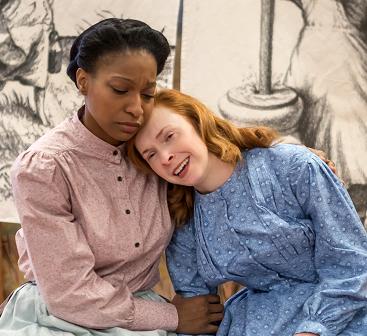
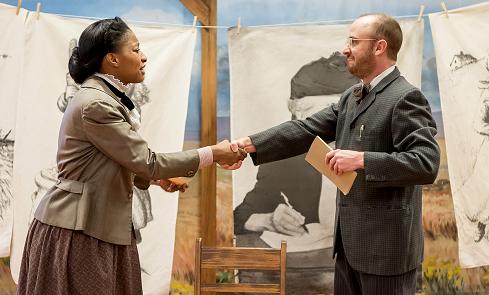
ArtReach's Laura
Ingalls Wilder - Rep St. Louis, Imaginary Theatre School Tour
Who's
Who
Laura Ingalls Wilder is
a strong willed girl, in the wilderness of the American Frontier.
Carolina Ingalls (Ma)
is Laura's mother. She is a brave woman who works hard to keep
her family safe.
Charles Ingalls (Pa) is
Laura's father. He has a strong sense of adventure and longs to
build a good life for his family.
Mary Ingalls is Laura's
older sister. She is a kind soul who becomes blind after
suffering a stroke brought on by scarlet fever.
Almonzo Wilder (Manly)
is a good young farmer who helps the Ingalls family after a hard
winter. He and Laura fall in love and are later married.
Rose Wilder is the
daughter of Laura and Manly. She has the same sense of
adventure as her grandfather, which takes her on travels around the
world. Rose is a gifted writer who publishers many books of her own.
Alfred Knopf is a
publisher who Rose convinces to publish her mother's manuscripts.
"Rose
has the same sense of adventure as her grandfather."
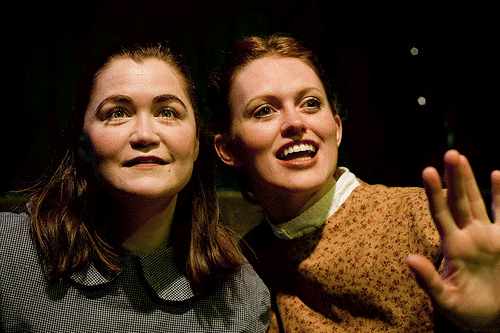
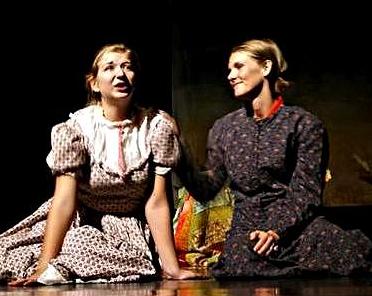
ArtReach's Laura
Ingalls Wilder - AD Players, Houston - The
TallGrass Theatre Company, Gardner, KS
Read
More About It
Want the learn more about
Laura's life or read some of her works? Check out these
selections, available at your local library.
Little House on the Prairie,
by Laura Ingalls Wilder
On the Way Home: The Diary
of a Trip from South Dakota to Mansfield, Missouri
in 1894, by Laura Ingalls Wilder, with a setting by Rose Wilder Lane
Pioneer Girl: The Story of
Laura Ingalls Wilder, by William Anderson
The World of Little House, by
Carolyn Strom Collins and Christina Wyss Eriksson
Little Author in the Big
Woods: A Biography of Laura Ingalls Wilder, by Yona Zeldis
McDonough, illustrated by Jennifer Thermes
The
Barter Theatre Production of ArtReach's Amelia
Earhart
Play by Kathryn
Schultz Miller
Study Guide
prepared by Catherine Bush, Barter Playwright-in-Residence
*Especially for
Grades 4-12, Barter ENCORE Players - March, 2017
"Stage
II presentation of Amelia Earhart
- what a great job! The three actors kept you captivated for 45
minutes. Very nice overview of Amelia's journey."
Review of Amelia Earhart performance on TripAdvisor, 2017
Questions/Activities
1. In this play, Amelia
Earhart is constantly compared with another groundbreaking American
pilot, Charles Lindbergh&ldots; Research the lives of Amelia
Earhart and Charles Lindberg, then write a paper comparing and
contrasting their childhoods, careers, politics, and place in
American history.
2. What is an altimeter? A
tachometer? How are they used in aviation? Why are they important?
What other instruments are necessary for safe flight? How many of
these instruments did Amelia Earhart have available for her use in
1937? Present your findings to the class.
3. At one point in her career,
Amelia Earhart became fascinated with a new invention, the autogiro.
What is an autogiro? How does it differ from an airplane? A
helicopter? Present your findings to the class.
On
Professional & High School stages across US!
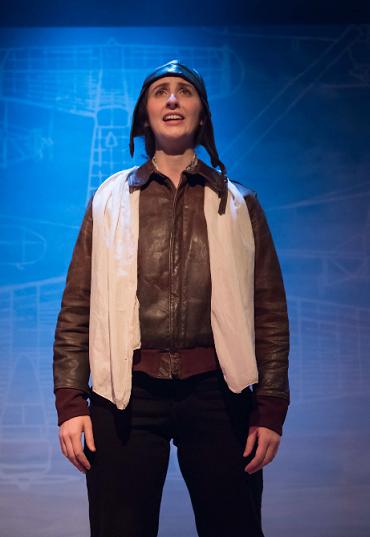
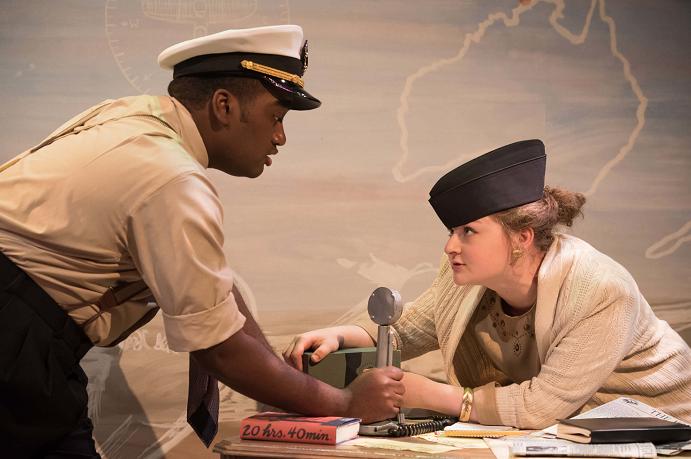
Amelia
Earhart on tour, Barter Theatre, Abington, VA
4. There are several theories
as to what happened to Amelia Earhart, some of which are suggested at
the end of this play. What do you think happened to Amelia Earhart? Discuss.
5. Discuss the existence of
gender inequalities in Earhart's time, and how these compare to those
that exist in the world today. Earhart once said, "There are a
great many boys who would be better off making pies, and a great many
girls who would be better off as mechanics." Do you agree with
this statement? Discuss the concept of gender roles and how this
comment might have been received in 1935. Why was this a bold
statement to make for the time? How would a statement like that be
received today, at your school? Discuss.
6. A pacifist, Amelia Earhart
believed that if there was to be a military draft, then women should
be drafted alongside the men for combat service. Can women be drafted
into military service in the United States? Do you think this is
fair? Why or why not? Discuss. How does the United States policy
about drafting women into military service compare with the country
of Israel? Do you think the United States should draft anyone,
regardless of gender? Discuss.
7. In regard to Amelia
Earhart, a historian once remarked that "She was completely
committed to the commercial property 'Amelia Earhart,' and was
absolutely driven to make it a recognized name brand." What is a
name brand? Cite some examples of more popular name brands. How to
people turn themselves into name brands? Make a list of people who
have managed to do exactly that.
Read
Washington Irving's The
Legend of Sleepy Hollow
Bio and Read
Aloud Discussions
Bio:
Washington Irving was born April 3, 1783, in New York
City. He was the youngest of a rich merchant's eleven children. In
school he was an average student who enjoyed music, books, and art.
Though he would practice law on Wall Street, work in his family's
cutlery business, and even serve (later in life) as U.S. Minister to
Spain, he loved books and writing. Much of his writing was influenced
by his travels including excursions up the Hudson River and a
two-year stay in southern Europe. While traveling, Irving filled
notebooks with his impressions of people and he wrote satires based
upon those notes. He published his first book, A History of New York,
in 1809, under his pen name, "Diedrich Knickerbocker."
Other famous books included The Sketch Book (1819, which included The
Legend of Sleepy Hollow and Rip Van Winkle), Tales of a Traveler
(1824), and The Alhambra (1832). Irving also wrote biographies of
Oliver Goldsmith, Mahomet, and George Washington. Irving never
married, being happy to spend his time at home with his brother and
five nieces. Washington Irving died on November 28, 1859 in
Irvington, New York.
Washington Irving's The Legend
of Sleepy Hollow was the first American work of fiction that achieved
acclaim in Europe. Set in New York State's Hudson Valley 20 years
after the Revolutionary War, Sleepy Hollow depicts the peaceful,
rural life of the early Dutch settlers in that area.
"Sleepy
Hollow depicts
the peaceful, life of early Dutch settlers."
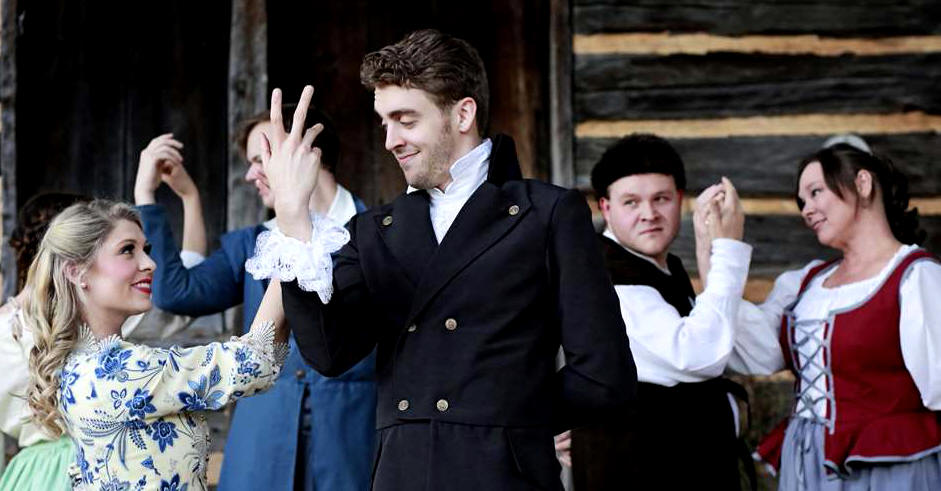
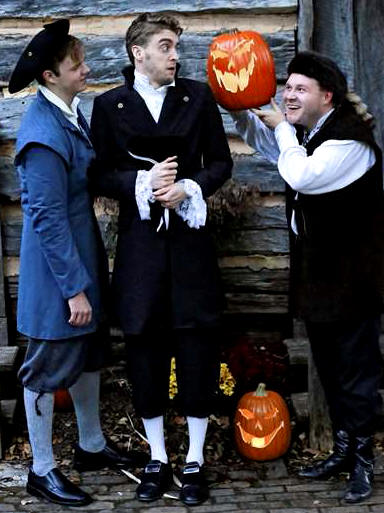
ArtReach's The
Legend of Sleepy Hollow - Jonesborough Repertory Theatre, TN
The Legend of Sleepy Hollow is
a wonderful read aloud, filled with marvelous descriptions and
humor. Once you've read it, choose from these cross-curricular
connections to extend the learning and the fun.
English:
The important characters of this story are described
in lively language, with lots of detail. Katrina van Tassel, the girl
whom both Ichabod and Brom are courting, is described only in terms
of her appearance, with a passage later about her parents suggesting
that she might be spoiled. Have students flesh out the character of
Katrina in a character sketch.
Many people have made plays
from this story - your class can do it, too! Write and stage the play
for your school, or film it for your class website.
While this story is accessible
to younger readers, the vocabulary can really be challenging. Collect
words from the story in a pocket chart or on chart paper and see how
many new ones you can learn while you're reading the story.
Social
Studies: Sleepy Hollow is a real place, and the
character of the place is important to the story. Irving says that
the people of Sleepy Hollow are inclined to see ghosts, and says of
visitors to the area, " However wide awake they may have been
before they entered that sleepy region, they are sure, in a little
time, to inhale the witching influence of the air, and begin to grow
imaginative, to dream dreams, and see apparitions." There is no
Google Earth Tour online yet for this story, so here's your chance!
"The
people of Sleepy Hollow are inclined to see ghosts."
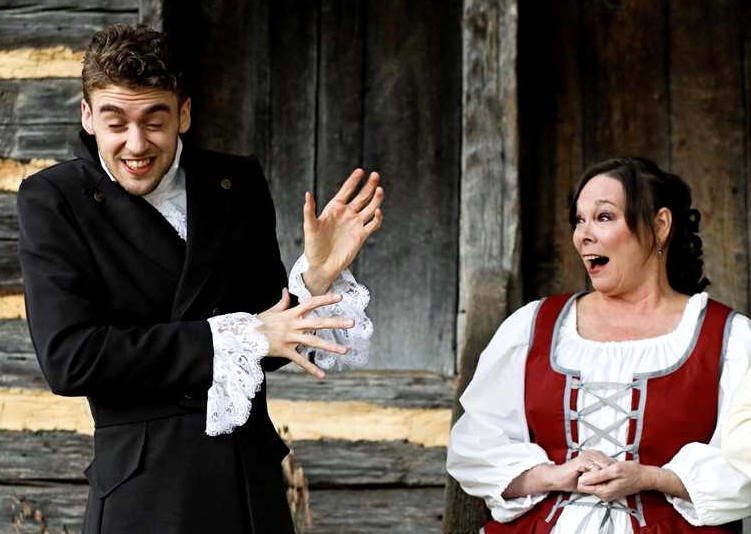
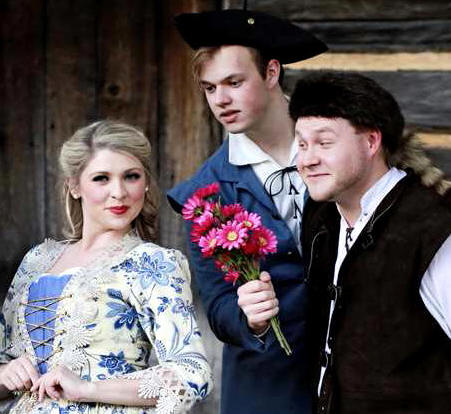
ArtReach's The
Legend of Sleepy Hollow - Jonesborough Repertory Theatre, TN
The
Smithsonian: The Smithsonian has
an intriguing lesson using "The Legend of Sleepy Hollow" to
explore contagion. With measles, Zika virus, and other contagious
diseases in the news, students will get a new perspective. (https://www.smithsonianmag.com/history/what-legend-sleepy-hollow-tells-us-about-contagion-fear-and-epidemics-180953192/)
The life of a teacher during
Colonial times (and after, in many areas) was difficult. Ichabod
Crane, like most teachers, earned very little and was given a place
to live by parents of his students. Things were different for
students, too - not least because of the use of corporal punishment,
which is described in the story. Use a Venn diagram to compare school
in Irving's day to your modern school.
"Sleepy
Hollow had lots of local ghost stories."

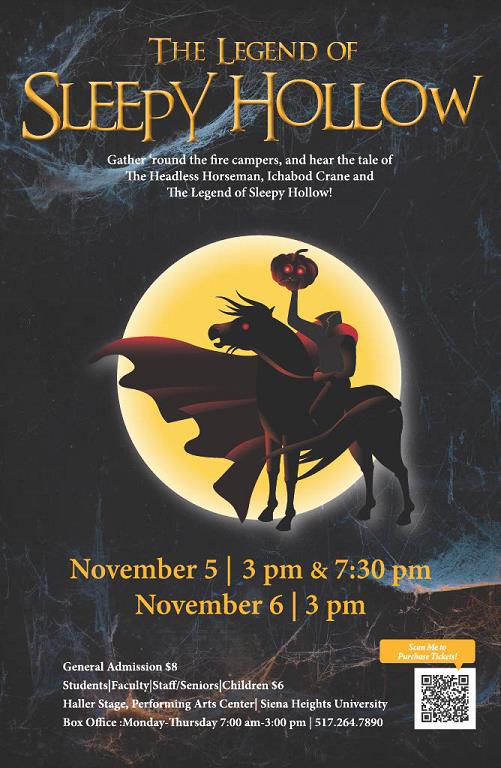
ArtReach's The
Legend of Sleepy Hollow - Siena Heights University, Adrian MI
Sleepy Hollow had lots of
local ghost stories, the most exciting one being the story of the
Headless Horseman. Have students research local ghost stories. If
there are no local ghost stories where you live, discuss why that
should be. Is Irving right in thinking that some places encourage
superstitious attitudes? Is your town too new to have developed any
ghost stories? This is a good opportunity for surveys and oral
history projects.
I
Think I Can: ArtReach's Small Cast Musical
Classroom
Activities for School
Performances
From
Merry-Go-Round Playhouse, Lisa Chase, Artistic Director • Erin
Katzker, Educational Theatre Manager
GRADES K-2
ASSEMBLY PROGRAM
Activities
Pre-Performance:
1. I Think I Can is a story of
how a young girl named Becky conquers her fears and learns to believe
in herself. At the beginning of the play, Becky doesn't think she can
do anything, because she doesn't realize she has great qualities that
will help her accomplish anything she puts her mind to. Think about
your great qualities. Describe yourself using the letters in your
first name as the first letters in each of your great qualities. For
example, Becky's List of Great Qualities might be: Brave,
Enthusiastic, Caring, Kind, and Youthful.
2. In our story, Becky tries
several new things that are hard for her at first. Think about a time
you did something that was difficult for you. Draw three pictures of
that situation: 1) the beginning, 2) the middle, and 3) the end of
the story. Using your pictures as a guide, tell your classmates the
story. Make sure you tell them where you were, what you were doing,
and how it ended up!
I
Think I Can: "Be Brave,
Enthusiastic, Caring, Kind"
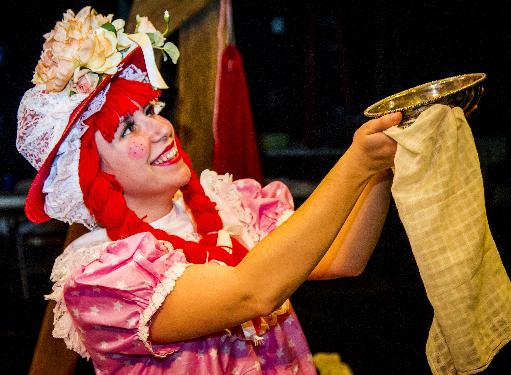
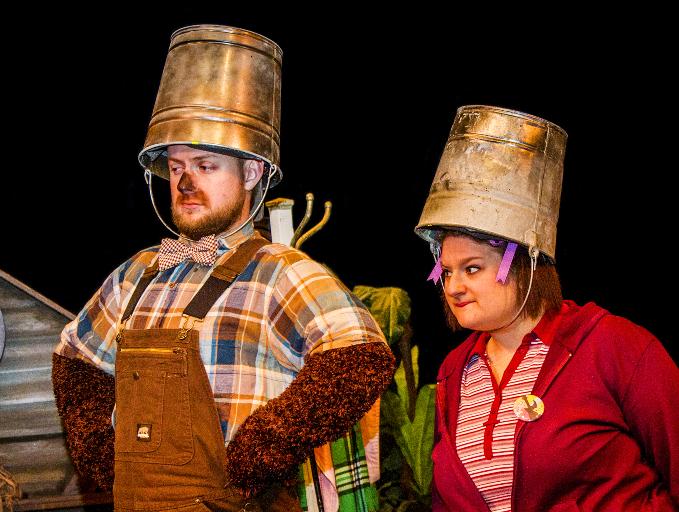
Merry-Go-Round Playhouse, NY - I
Think I Can, Musical for Kids
Post-Performance:
1. Becky spends most of the
story trying to decide what she wants to be when she grows up. What
is your dream job, and why? Draw a picture of yourself doing this
job. Remember, just like Becky, it's okay if you don't know what you
want to be yet! Just draw a picture of a job you might like to try
one day!
2. Professor, Becky's house
cat, also serves as her personal advisor, helping her with difficult
homework assignments and giving her encouragement and confidence. Do
you know anyone like Professor, who encourages you to always try your
best? Write a letter to this person thanking them for their advice
and encouragement. Include what you would say to this person if they
needed you to help boost their confidence.
3. In our story, Becky is
elected President of the World! What would you do if you were
President of the World? Work with a classmate to create a world with
you as the President. What is this world called? What holidays do
people celebrate? What would kids learn in school? When would people
go to bed? What would people eat? Present to your class about what a
typical day would be like in your world. You can draw pictures, make
a collage, write a story-whatever you want! Be creative!



























































